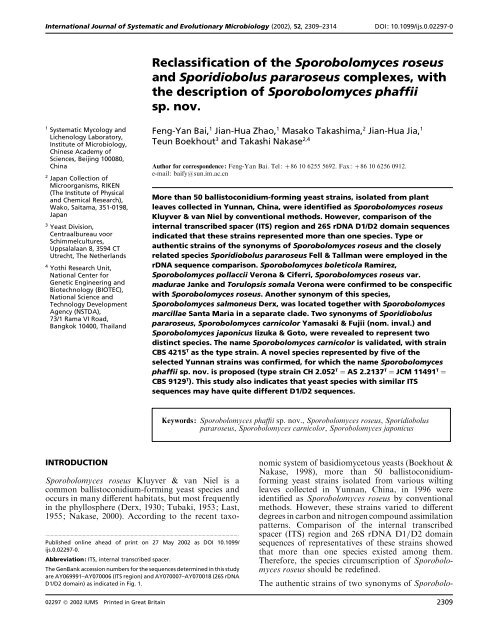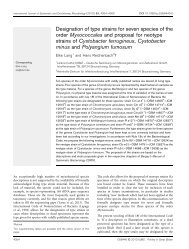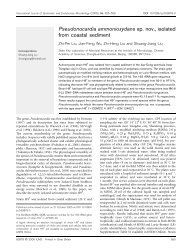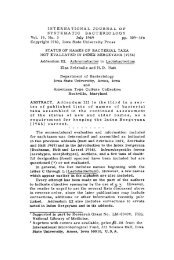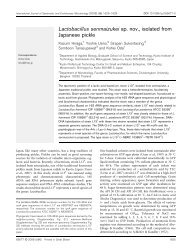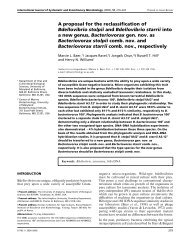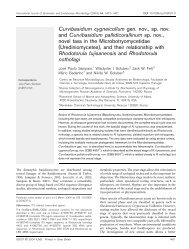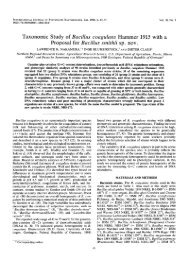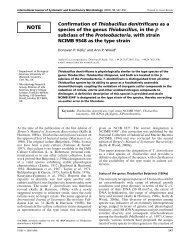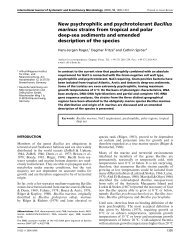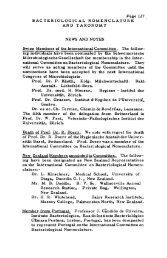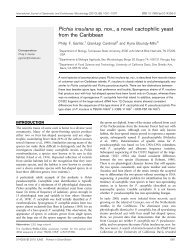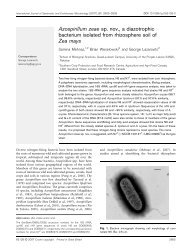Reclassification of the Sporobolomyces roseus - International ...
Reclassification of the Sporobolomyces roseus - International ...
Reclassification of the Sporobolomyces roseus - International ...
You also want an ePaper? Increase the reach of your titles
YUMPU automatically turns print PDFs into web optimized ePapers that Google loves.
<strong>International</strong> Journal <strong>of</strong> Systematic and Evolutionary Microbiology (2002), 52, 2309–2314 DOI: 10.1099/ijs.0.02297-0<br />
1 Systematic Mycology and<br />
Lichenology Laboratory,<br />
Institute <strong>of</strong> Microbiology,<br />
Chinese Academy <strong>of</strong><br />
Sciences, Beijing 100080,<br />
China<br />
2 Japan Collection <strong>of</strong><br />
Microorganisms, RIKEN<br />
(The Institute <strong>of</strong> Physical<br />
and Chemical Research),<br />
Wako, Saitama, 351-0198,<br />
Japan<br />
3 Yeast Division,<br />
Centraalbureau voor<br />
Schimmelcultures,<br />
Uppsalalaan 8, 3594 CT<br />
Utrecht, The Ne<strong>the</strong>rlands<br />
4 Yothi Research Unit,<br />
National Center for<br />
Genetic Engineering and<br />
Biotechnology (BIOTEC),<br />
National Science and<br />
Technology Development<br />
Agency (NSTDA),<br />
73/1 Rama VI Road,<br />
Bangkok 10400, Thailand<br />
INTRODUCTION<br />
<strong>Sporobolomyces</strong> <strong>roseus</strong> Kluyver & van Niel is a<br />
common ballistoconidium-forming yeast species and<br />
occurs in many different habitats, but most frequently<br />
in <strong>the</strong> phyllosphere (Derx, 1930; Tubaki, 1953; Last,<br />
1955; Nakase, 2000). According to <strong>the</strong> recent taxo-<br />
.................................................................................................................................................<br />
Published online ahead <strong>of</strong> print on 27 May 2002 as DOI 10.1099/<br />
ijs.0.02297-0.<br />
Abbreviation: ITS, internal transcribed spacer.<br />
The GenBank accession numbers for <strong>the</strong> sequences determined in this study<br />
are AY069991–AY070006 (ITS region) and AY070007–AY070018 (26S rDNA<br />
D1/D2 domain) as indicated in Fig. 1.<br />
<strong>Reclassification</strong> <strong>of</strong> <strong>the</strong> <strong>Sporobolomyces</strong> <strong>roseus</strong><br />
and Sporidiobolus para<strong>roseus</strong> complexes, with<br />
<strong>the</strong> description <strong>of</strong> <strong>Sporobolomyces</strong> phaffii<br />
sp. nov.<br />
Feng-Yan Bai, 1 Jian-Hua Zhao, 1 Masako Takashima, 2 Jian-Hua Jia, 1<br />
Teun Boekhout 3 and Takashi Nakase 2,4<br />
Author for correspondence: Feng-Yan Bai. Tel: 86 10 6255 5692. Fax: 86 10 6256 0912.<br />
e-mail: baifysun.im.ac.cn<br />
More than 50 ballistoconidium-forming yeast strains, isolated from plant<br />
leaves collected in Yunnan, China, were identified as <strong>Sporobolomyces</strong> <strong>roseus</strong><br />
Kluyver & van Niel by conventional methods. However, comparison <strong>of</strong> <strong>the</strong><br />
internal transcribed spacer (ITS) region and 26S rDNA D1/D2 domain sequences<br />
indicated that <strong>the</strong>se strains represented more than one species. Type or<br />
au<strong>the</strong>ntic strains <strong>of</strong> <strong>the</strong> synonyms <strong>of</strong> <strong>Sporobolomyces</strong> <strong>roseus</strong> and <strong>the</strong> closely<br />
related species Sporidiobolus para<strong>roseus</strong> Fell & Tallman were employed in <strong>the</strong><br />
rDNA sequence comparison. <strong>Sporobolomyces</strong> boleticola Ramırez,<br />
<strong>Sporobolomyces</strong> pollaccii Verona & Ciferri, <strong>Sporobolomyces</strong> <strong>roseus</strong> var.<br />
madurae Janke and Torulopsis somala Verona were confirmed to be conspecific<br />
with <strong>Sporobolomyces</strong> <strong>roseus</strong>. Ano<strong>the</strong>r synonym <strong>of</strong> this species,<br />
<strong>Sporobolomyces</strong> salmoneus Derx, was located toge<strong>the</strong>r with <strong>Sporobolomyces</strong><br />
marcillae Santa Maria in a separate clade. Two synonyms <strong>of</strong> Sporidiobolus<br />
para<strong>roseus</strong>, <strong>Sporobolomyces</strong> carnicolor Yamasaki & Fujii (nom. inval.) and<br />
<strong>Sporobolomyces</strong> japonicus Iizuka & Goto, were revealed to represent two<br />
distinct species. The name <strong>Sporobolomyces</strong> carnicolor is validated, with strain<br />
CBS 4215 T as <strong>the</strong> type strain. A novel species represented by five <strong>of</strong> <strong>the</strong><br />
selected Yunnan strains was confirmed, for which <strong>the</strong> name <strong>Sporobolomyces</strong><br />
phaffii sp. nov. is proposed (type strain CH 2.052 T AS 2.2137 T JCM 11491 T <br />
CBS 9129 T ). This study also indicates that yeast species with similar ITS<br />
sequences may have quite different D1/D2 sequences.<br />
Keywords: <strong>Sporobolomyces</strong> phaffii sp. nov., <strong>Sporobolomyces</strong> <strong>roseus</strong>, Sporidiobolus<br />
para<strong>roseus</strong>, <strong>Sporobolomyces</strong> carnicolor, <strong>Sporobolomyces</strong> japonicus<br />
nomic system <strong>of</strong> basidiomycetous yeasts (Boekhout &<br />
Nakase, 1998), more than 50 ballistoconidiumforming<br />
yeast strains isolated from various wilting<br />
leaves collected in Yunnan, China, in 1996 were<br />
identified as <strong>Sporobolomyces</strong> <strong>roseus</strong> by conventional<br />
methods. However, <strong>the</strong>se strains varied to different<br />
degrees in carbon and nitrogen compound assimilation<br />
patterns. Comparison <strong>of</strong> <strong>the</strong> internal transcribed<br />
spacer (ITS) region and 26S rDNA D1D2 domain<br />
sequences <strong>of</strong> representatives <strong>of</strong> <strong>the</strong>se strains showed<br />
that more than one species existed among <strong>the</strong>m.<br />
Therefore, <strong>the</strong> species circumscription <strong>of</strong> <strong>Sporobolomyces</strong><br />
<strong>roseus</strong> should be redefined.<br />
The au<strong>the</strong>ntic strains <strong>of</strong> two synonyms <strong>of</strong> Sporobolo-<br />
02297 2002 IUMS Printed in Great Britain 2309
F.-Y. Bai and o<strong>the</strong>rs<br />
myces <strong>roseus</strong>, <strong>Sporobolomyces</strong> ruberrimus Yamasaki &<br />
Fujii var. ruberrimus (CBS 7500) and <strong>Sporobolomyces</strong><br />
ruberrimus var. albus Yamasaki & Fujii (CBS 7253,<br />
CBS 7501), have been shown to represent a distinct<br />
species by D1D2 domain sequence analysis (Fell et<br />
al., 2000). The type or au<strong>the</strong>ntic strains <strong>of</strong> <strong>the</strong><br />
remaining synonyms <strong>of</strong> <strong>Sporobolomyces</strong> <strong>roseus</strong> were<br />
employed in <strong>the</strong> present study, when available from<br />
culture collections. Since <strong>Sporobolomyces</strong> <strong>roseus</strong> is<br />
phenotypically similar and phylogenetically closely<br />
related to <strong>Sporobolomyces</strong> shibatanus (Okunuki)<br />
Verona & Ciferri, <strong>the</strong> anamorph <strong>of</strong> Sporidiobolus<br />
para<strong>roseus</strong> Fell & Tallman (Boekhout, 1991; Boekhout<br />
& Nakase, 1998; Hamamoto & Nakase, 2000), <strong>the</strong><br />
type strains <strong>of</strong> <strong>the</strong> synonyms <strong>of</strong> <strong>the</strong> latter species were<br />
also included. The taxonomic status <strong>of</strong> <strong>the</strong>se taxa was<br />
clarified by ITS region and D1D2 domain sequence<br />
analysis. The taxonomic positions <strong>of</strong> representative<br />
Yunnan strains were determined and a hi<strong>the</strong>rto undescribed<br />
yeast species was found among <strong>the</strong>m. We<br />
describe <strong>the</strong> latter as <strong>Sporobolomyces</strong> phaffii sp. nov.,<br />
in honour <strong>of</strong> <strong>the</strong> late Herman J. Phaff.<br />
METHODS<br />
Yeast strains and characterization. The yeast strains<br />
examined are listed in Table 1. The strains from Yunnan<br />
Table 1. Yeast strains employed<br />
Strain Source/notes<br />
Sporidiobolus para<strong>roseus</strong><br />
CBS 491T Soil<br />
CBS 484 Type <strong>of</strong> <strong>Sporobolomyces</strong> para<strong>roseus</strong><br />
<strong>Sporobolomyces</strong> blumeae JCM 10212T Blumea sp.<br />
<strong>Sporobolomyces</strong> carnicolor CBS 4215T Unknown<br />
<strong>Sporobolomyces</strong> japonicus CBS 5744T Oil brine<br />
<strong>Sporobolomyces</strong> marcillae CBS 4217T Air<br />
<strong>Sporobolomyces</strong> phaffii sp. nov.<br />
CH 2.049 Wilting leaf <strong>of</strong> Ehretia corylifolia<br />
CH 2.052T Wilting leaf <strong>of</strong> Nerium indicum<br />
CH 2.083 Wilting leaf <strong>of</strong> Oxytenan<strong>the</strong>ra sp.<br />
CH 2.091 Wilting leaf <strong>of</strong> Eriobotrya japonica<br />
CH 2.304 Wilting leaf <strong>of</strong> Oryza sativa<br />
<strong>Sporobolomyces</strong> <strong>roseus</strong><br />
CBS 485 Type <strong>of</strong> <strong>Sporobolomyces</strong> pollaccii<br />
CBS 486T Type <strong>of</strong> <strong>Sporobolomyces</strong> <strong>roseus</strong><br />
CBS 993 Type <strong>of</strong> Torulopsis somala<br />
CBS 2646 Type <strong>of</strong> <strong>Sporobolomyces</strong> <strong>roseus</strong> var. madurae<br />
CBS 2840 Au<strong>the</strong>ntic strain <strong>of</strong> <strong>Sporobolomyces</strong> boleticola<br />
CBS 2841 Au<strong>the</strong>ntic strain <strong>of</strong> <strong>Sporobolomyces</strong> boleticola<br />
CH 2.053 Wilting leaf <strong>of</strong> Nerium indicum<br />
CH 2.116 Wilting leaf <strong>of</strong> Sapindus delavayi<br />
CH 2.332 Wilting leaf <strong>of</strong> Nicotiana tabacum<br />
<strong>Sporobolomyces</strong> ruberrimus CBS 7500T Air<br />
<strong>Sporobolomyces</strong> salmoneus CBS 488T Etiolated grass<br />
<strong>Sporobolomyces</strong> sp. CH 2.500 Wilting leaf <strong>of</strong> Par<strong>the</strong>nocissus sp.<br />
were isolated by <strong>the</strong> improved ballistoconidium-fall method<br />
(Nakase & Takashima, 1993). Type and au<strong>the</strong>ntic strains<br />
were obtained from <strong>the</strong> Centraalbureau voor Schimmelcultures<br />
(CBS), The Ne<strong>the</strong>rlands, and <strong>the</strong> Japan Collection<br />
<strong>of</strong> Microorganisms (JCM), Japan.<br />
Most <strong>of</strong> <strong>the</strong> morphological, physiological and biochemical<br />
characteristics were examined according to standard<br />
methods commonly employed in yeast taxonomy (Yarrow,<br />
1998). Assimilation <strong>of</strong> nitrogen compounds was investigated<br />
on solid media with starved inocula as described by Nakase<br />
& Suzuki (1986). Vitamin requirement tests were performed<br />
according to Komagata & Nakase (1967).<br />
Extraction, purification and identification <strong>of</strong> ubiquinones<br />
were carried out according to Nakase & Suzuki (1986).<br />
Xylose in <strong>the</strong> cell hydrolysate was analysed by HPLC as<br />
described by Suzuki & Nakase (1988).<br />
ITS region and 26S rDNA D1/D2 domain sequencing. Nuclear<br />
DNA was extracted using <strong>the</strong> method <strong>of</strong> Makimura et al.<br />
(1994). The DNA fragment covering <strong>the</strong> ITS region and 26S<br />
rDNA D1D2 domain was amplified with <strong>the</strong> primers ITS1<br />
(5-GTCGTAACAAGGTTTCCGTAGGTG-3) and NL4<br />
(5-GGTCCGTGTTTCAAGACGG-3). PCR was performed<br />
for 36 cycles <strong>of</strong> denaturation at 94 C for 1 min,<br />
annealing at 52 C for 1 min and extension at 72 C for<br />
15 min. Cycle sequencing was performed with <strong>the</strong> forward<br />
primers ITS1 and NL1 (5-GCATATCAATAAGCGGA-<br />
GGAAAAG-3) and <strong>the</strong> reverse primers ITS4 (5-TCCTC-<br />
CGCTTATTGATATGC-3) and NL4 using <strong>the</strong> ABI<br />
2310 <strong>International</strong> Journal <strong>of</strong> Systematic and Evolutionary Microbiology 52
BigDye cycle sequencing kit. Electrophoresis was done on<br />
an ABI PRISM 377 DNA sequencer.<br />
Molecular phylogenetic analysis. The sequences <strong>of</strong> <strong>the</strong> ITS<br />
regions or 26S rDNA D1D2 domains <strong>of</strong> <strong>the</strong> strains<br />
determined in this study and <strong>the</strong> reference sequences were<br />
aligned with <strong>the</strong> program clustal x (Thompson et al., 1997)<br />
and adjusted manually. Reference sequences were obtained<br />
from DDBJEMBLGenBank, where <strong>the</strong>y had been deposited<br />
by o<strong>the</strong>r authors (Fell et al., 2000; Takashima &<br />
Nakase, 2000). Phylogenetic trees were constructed from <strong>the</strong><br />
evolutionary distance data calculated from Kimura’s twoparameter<br />
model (Kimura, 1980) using <strong>the</strong> neighbourjoining<br />
method (Saitou & Nei, 1987). Bootstrap analyses<br />
(Felsenstein, 1985) were performed on 1000 random<br />
resamplings.<br />
RESULTS AND DISCUSSION<br />
Taxonomic status <strong>of</strong> <strong>the</strong> synonyms <strong>of</strong><br />
<strong>Sporobolomyces</strong> <strong>roseus</strong> and Sporidiobolus<br />
para<strong>roseus</strong><br />
Boekhout (1991) and Boekhout & Nakase (1998) listed<br />
15 taxonomic synonyms under <strong>Sporobolomyces</strong> <strong>roseus</strong>.<br />
The type or au<strong>the</strong>ntic strains are available from culture<br />
collections for only eight <strong>of</strong> <strong>the</strong>m. The sequences <strong>of</strong> <strong>the</strong><br />
ITS regions and D1D2 domains <strong>of</strong> <strong>the</strong>se strains were<br />
determined in <strong>the</strong> present study, except for <strong>the</strong> D1D2<br />
sequence <strong>of</strong> <strong>the</strong> type strain <strong>of</strong> <strong>Sporobolomyces</strong><br />
ruberrimus, which had been determined by Fell et al.<br />
(2000).<br />
Among <strong>the</strong> taxonomic synonyms <strong>of</strong> Sporidiobolus<br />
para<strong>roseus</strong> listed by Boekhout (1991) and Boekhout &<br />
Nakase (1998), <strong>Sporobolomyces</strong> para<strong>roseus</strong> Olson &<br />
Hammer (CBS 484T, mt A1) and <strong>Sporobolomyces</strong><br />
ruber Yamasaki & Fujii (nom. inval., CBS 4216, mt<br />
A2) have been confirmed to be conspecific with <strong>the</strong><br />
former by mating compatibility and D1D2<br />
sequencing (Boekhout, 1991; Statzell-Tallman & Fell,<br />
1998; Fell et al., 2000). <strong>Sporobolomyces</strong> marcillae<br />
Santa Maria was shown to be a distinct species by<br />
D1D2 sequencing (Fell et al., 2000). The type or<br />
au<strong>the</strong>ntic strains <strong>of</strong> <strong>the</strong> remaining two synonyms <strong>of</strong><br />
Sporidiobolus para<strong>roseus</strong>, <strong>Sporobolomyces</strong> carnicolor<br />
Yamasaki & Fujii (nom. inval.) and <strong>Sporobolomyces</strong><br />
japonicus Iizuka & Goto, were used in this study for<br />
ITS and D1D2 sequencing. In addition, <strong>the</strong> ITS<br />
sequence <strong>of</strong> <strong>the</strong> type strain <strong>of</strong> <strong>Sporobolomyces</strong><br />
marcillae was determined.<br />
The relationships among <strong>the</strong> taxa studied are depicted<br />
by <strong>the</strong> phylogenetic trees drawn from <strong>the</strong> sequences <strong>of</strong><br />
<strong>the</strong> ITS region (Fig. 1a) and <strong>the</strong> D1D2 domain (Fig.<br />
1b). Sporidiobolus johnsonii and Sporidiobolus salmonicolor<br />
were used as outgroups. The recently described<br />
species <strong>Sporobolomyces</strong> blumeae Takashima & Nakase<br />
(2000) formed a basal branch in both trees. The o<strong>the</strong>r<br />
taxa clustered around <strong>Sporobolomyces</strong> <strong>roseus</strong> and<br />
Sporidiobolus para<strong>roseus</strong>. In <strong>the</strong> ITS tree (Fig. 1a),<br />
both clades were supported strongly (99–100%) by<br />
bootstrap analysis. In <strong>the</strong> D1D2 tree (Fig. 1b), <strong>the</strong><br />
<strong>Sporobolomyces</strong> <strong>roseus</strong> clade was strongly supported<br />
<strong>Sporobolomyces</strong> phaffii sp. nov.<br />
(bootstrap value 100%), but <strong>the</strong> Sporidiobolus<br />
para<strong>roseus</strong> clade was not (bootstrap value 50%).<br />
Among <strong>the</strong> synonyms <strong>of</strong> <strong>Sporobolomyces</strong> <strong>roseus</strong>,<br />
<strong>Sporobolomyces</strong> boleticola Ramırez, <strong>Sporobolomyces</strong><br />
pollaccii Verona & Ciferri, <strong>Sporobolomyces</strong> <strong>roseus</strong> var.<br />
madurae Janke and Torulopsis somala Verona were<br />
confirmed to be conspecific with <strong>Sporobolomyces</strong><br />
<strong>roseus</strong>, because <strong>the</strong>y have ITS and D1D2 sequences<br />
that are identical or very similar (only one nucleotide<br />
substitution) to those <strong>of</strong> <strong>the</strong> type strain <strong>of</strong> <strong>Sporobolomyces</strong><br />
<strong>roseus</strong>.<br />
<strong>Sporobolomyces</strong> salmoneus Derx, a synonym <strong>of</strong> <strong>Sporobolomyces</strong><br />
<strong>roseus</strong>, was clearly separated from <strong>the</strong><br />
<strong>Sporobolomyces</strong> <strong>roseus</strong> clade in both trees, and<br />
clustered toge<strong>the</strong>r with <strong>Sporobolomyces</strong> marcillae in<br />
<strong>the</strong> Sporidiobolus para<strong>roseus</strong> clade. The type strains <strong>of</strong><br />
<strong>Sporobolomyces</strong> salmoneus and <strong>Sporobolomyces</strong><br />
marcillae have identical D1D2 sequences and differ<br />
by only 1 nt in <strong>the</strong>ir ITS regions.<br />
Two synonyms <strong>of</strong> Sporidiobolus para<strong>roseus</strong>, <strong>Sporobolomyces</strong><br />
carnicolor and <strong>Sporobolomyces</strong> japonicus,<br />
respectively differed from <strong>the</strong> type strain by 19–24 and<br />
7–8 nt in <strong>the</strong> ITS region and D1D2 domain. They also<br />
differed from one ano<strong>the</strong>r remarkably (Fig. 1). <strong>Sporobolomyces</strong><br />
carnicolor and <strong>Sporobolomyces</strong> japonicus<br />
should <strong>the</strong>refore be reinstalled as two distinct species.<br />
<strong>Sporobolomyces</strong> carnicolor was proposed by Yamasaki<br />
& Fujii (1950) without a Latin description or type<br />
designation, and <strong>the</strong>refore needs to be validated.<br />
Taxonomic status <strong>of</strong> <strong>the</strong> <strong>Sporobolomyces</strong> <strong>roseus</strong><br />
strains from Yunnan<br />
A total <strong>of</strong> 670 yeast strains were isolated from 43<br />
wilting leaf samples collected in Yunnan, China, in<br />
1996 using <strong>the</strong> improved ballistoconidium-fall method<br />
(Nakase & Takashima, 1993). Approximately 100<br />
ballistoconidium-forming yeast strains were initially<br />
selected for phenotypic characterization. Of <strong>the</strong>m, a<br />
total <strong>of</strong> 55 strains were identified as <strong>Sporobolomyces</strong><br />
<strong>roseus</strong> according to Boekhout (1991) and Boekhout &<br />
Nakase (1998). Of nine representative strains (Table 1)<br />
selected for ITS sequencing, strains CH 2.053, CH<br />
2.116 and CH 2.332 were confirmed to belong to<br />
<strong>Sporobolomyces</strong> <strong>roseus</strong> (Fig. 1a). The sequence <strong>of</strong><br />
strain CH 2.500 differed from that <strong>of</strong> <strong>the</strong> type by 5 nt<br />
(14%).<br />
The o<strong>the</strong>r five strains, CH 2.049, CH 2.052, CH 2.083,<br />
CH 2.091 and CH 2.304, had identical ITS sequences<br />
and <strong>the</strong> sequence differed from that <strong>of</strong> <strong>the</strong> type strain<br />
<strong>of</strong> <strong>Sporobolomyces</strong> ruberrimus by 3 nt (10%). Previous<br />
studies on basidiomycetous yeasts have indicated that<br />
conspecific strains usually have less than 1%<br />
nucleotide divergence in <strong>the</strong> ITS1 and ITS2 regions<br />
overall (Sugita et al., 1999a, b; Takashima & Nakase,<br />
2000). However, Bai et al. (2001a, b) found that<br />
conspecific strains might have up to 5–7 nt differences<br />
(approx. 2%) in <strong>the</strong> ITS regions. Therefore, <strong>the</strong><br />
taxonomic relationships <strong>of</strong> <strong>the</strong>se five strains with<br />
http://ijs.sgmjournals.org 2311
F.-Y. Bai and o<strong>the</strong>rs<br />
(a)<br />
(b)<br />
<strong>Sporobolomyces</strong> ruberrimus and that <strong>of</strong> strain CH<br />
2.500 with <strong>Sporobolomyces</strong> <strong>roseus</strong> were examined<br />
fur<strong>the</strong>r by D1D2 sequencing.<br />
Strains CH 2.052, CH 2.083, CH 2.091 and CH 2.304<br />
had identical D1D2 sequences and differed from CH<br />
2049 by only 1 nt. They differed from <strong>Sporobolomyces</strong><br />
ruberrimus in as many as 18–19 nt (30%) in <strong>the</strong><br />
D1D2 domain (Fig. 1b). These results indicate that<br />
<strong>the</strong>se strains represent a distinct species, for which <strong>the</strong><br />
name <strong>Sporobolomyces</strong> phaffii sp. nov. is proposed.<br />
Strain CH 2.500 differed from <strong>the</strong> type strain <strong>of</strong><br />
<strong>Sporobolomyces</strong> <strong>roseus</strong> by 3 nt in <strong>the</strong> D1D2 domain,<br />
suggesting that this strain probably represents a<br />
distinct species. A definite taxonomic decision for<br />
strain CH 2.500 should be supported by additional<br />
data, for example, DNA–DNA reassociation, and<br />
perhaps by <strong>the</strong> identification <strong>of</strong> additional strains.<br />
.....................................................................................................<br />
Fig. 1. Phylogenetic trees drawn from<br />
neighbour-joining analysis based on<br />
sequences <strong>of</strong> (a) <strong>the</strong> ITS region (including<br />
58S rDNA) and (b) <strong>the</strong> D1/D2 domain,<br />
depicting <strong>the</strong> relationships <strong>of</strong> taxa in <strong>the</strong><br />
<strong>Sporobolomyces</strong> <strong>roseus</strong> and Sporidiobolus<br />
para<strong>roseus</strong> complexes, as well as <strong>the</strong> novel<br />
isolates from Yunnan, China. Bootstrap<br />
percentages over 50% from 1000 bootstrap<br />
replicates are shown.<br />
The significance <strong>of</strong> phenotypic and phylogenetic<br />
comparison<br />
The novel species <strong>Sporobolomyces</strong> phaffii is indistinguishable<br />
from <strong>Sporobolomyces</strong> <strong>roseus</strong> by conventional<br />
characterization. The three species <strong>Sporobolomyces</strong><br />
carnicolor, <strong>Sporobolomyces</strong> japonicus and<br />
Sporidiobolus para<strong>roseus</strong> also have almost identical<br />
phenotypes. <strong>Sporobolomyces</strong> <strong>roseus</strong> and <strong>Sporobolomyces</strong><br />
phaffii can be differentiated from <strong>the</strong> latter<br />
three species in <strong>the</strong>ir ability to assimilate nitrate and<br />
nitrite. Though <strong>the</strong> type strains <strong>of</strong> <strong>Sporobolomyces</strong><br />
salmoneus and <strong>Sporobolomyces</strong> marcillae have identical<br />
D1D2 sequences and very similar ITS sequences,<br />
<strong>the</strong>ir nitrogen assimilation patterns are completely<br />
different. <strong>Sporobolomyces</strong> salmoneus can utilize nitrate,<br />
nitrite and ethylamine hydrochloride as sole sources <strong>of</strong><br />
nitrogen, whereas <strong>Sporobolomyces</strong> marcillae can not.<br />
This explains why <strong>the</strong> former was previously regarded<br />
2312 <strong>International</strong> Journal <strong>of</strong> Systematic and Evolutionary Microbiology 52
as a synonym <strong>of</strong> <strong>Sporobolomyces</strong> <strong>roseus</strong> and <strong>the</strong> latter<br />
a synonym <strong>of</strong> Sporidiobolus para<strong>roseus</strong> (Boekhout,<br />
1991). The taxonomic relationship between <strong>Sporobolomyces</strong><br />
salmoneus and <strong>Sporobolomyces</strong> marcillae<br />
should be studied fur<strong>the</strong>r.<br />
The relationships among <strong>the</strong> taxa in <strong>the</strong> Sporidiobolus<br />
para<strong>roseus</strong> complex revealed by <strong>the</strong> ITS sequences are<br />
discordant with those revealed by <strong>the</strong> D1D2 sequence<br />
data, especially for <strong>the</strong> relationship between <strong>Sporobolomyces</strong><br />
phaffii sp. nov. and <strong>Sporobolomyces</strong><br />
ruberrimus (Fig. 1). Analysis <strong>of</strong> 18S rDNA sequences<br />
may be helpful to confirm <strong>the</strong> phylogenetic relationships<br />
among <strong>the</strong>se species. Fell et al. (2000) found<br />
that some basidiomycetous yeast species with identical<br />
or similar D1D2 sequences could be separated<br />
by ITS sequence data. On <strong>the</strong> o<strong>the</strong>r hand, <strong>the</strong> present<br />
study indicates that species with similar ITS sequences<br />
may have quite different D1D2 sequence data.<br />
Latin diagnosis <strong>of</strong> <strong>Sporobolomyces</strong> carnicolor<br />
Yamasaki & Fujii ex Bai & Boekhout<br />
In YM liquido post dies 3 ad 25 C, cellulae vegetativae<br />
ovoideae, ellipsoideae vel elongatae, 25–6235–<br />
17 µm, singulae, binae vel aggregatae. Post unum<br />
mensem ad 20 C, annulus, pelliculum et sedimentum<br />
formantur. In agaro YM post unum mensem ad 20 C,<br />
cultura rubro-aurantiaca, rugosa, margine erosa. Mycelium<br />
et pseudomycelium non formantur. Ballistosporae<br />
ovoideae vel ellipsoideae, 25–3762–102 µm.<br />
Fermentatio nulla. Glucosum, galactosum (lente), lsorbosum<br />
(lente), saccharosum, maltosum, cellobiosum,<br />
trehalosum, raffinosum, melezitosum, inulinum (lente),<br />
amylum solubile (lente), d-xylosum (lente), d-arabinosum,<br />
d-ribosum, ethanolum, glycerolum, ribitolum<br />
(lente), d-mannitolum, glucitolum, methyl α-d-glucosidum<br />
(lente), salicinum, glucono-δ-lactonum, acidum<br />
succinicum et acidum citricum assimilantur at non lactosum,<br />
melibiosum, l-arabinosum, l-rhamnosum, erithritolum,<br />
galactitolum, acidum 2-ketogluconicum, acidum<br />
5-ketogluconicum, acidum dl-lacticum, inositolum,<br />
acidum d-glucuronicum nec acidum d-galacturonicum.<br />
Ammonium sulfatum, l-lysinum et cadaverinum assimilantur<br />
at non kalium nitricum, natrum nitrosum nec<br />
ethylaminum. Ad crescentiam vitaminum non necessarium<br />
est. Materia amyloidea iodophila non formantur.<br />
Urea finditur. Diazonium caeruleum B positivum. Ubiquinonum<br />
majus: Q-10. Typus: CBS 4215T, depositus in<br />
collectione Centraalbureau voor Schimmelcultures,<br />
Utrecht, The Ne<strong>the</strong>rlands.<br />
Latin diagnosis <strong>of</strong> <strong>Sporobolomyces</strong> phaffii Bai,<br />
Takashima & Nakase sp. nov.<br />
In YM (Difco) liquido post dies 3 ad 25 C, cellulae<br />
vegetativae ovoideae vel ellipsoideae, 20–4040–<br />
48 µm, singulae aut binae. Post unum mensem ad 20 C,<br />
annulus, pelliculum et sedimentum formantur. In agaro<br />
YM post unum mensem ad 20 C, cultura rubroaurantiaca,<br />
glabra, nitida, et margine glabra. Mycelium<br />
et pseudomycelium non formantur. Ballistosporae ovoi-<br />
<strong>Sporobolomyces</strong> phaffii sp. nov.<br />
deae vel ellipsoideae,20–2280–90 µm. Fermentatio<br />
nulla. Glucosum, saccharosum, maltosum, cellobiosum,<br />
trehalosum, melibiosum, raffinosum, melezitosum, amylum<br />
solubile, ethanolum (lente), d-mannitolum (lente),<br />
methyl α-d-glucosidum, salicinum, glucono-δ-lactonum<br />
et acidum succinicum assimilantur at non galactosum<br />
(vel exigue et lente), l-sorbosum, lactosum, inulinum, dxylosum,<br />
l-arabinosum, d-arabinosum, d-ribosum, lrhamnosum,<br />
glycerolum, erithritolum, ribitolum, galactitolum,<br />
glucitolum (vel exigue et lente), acidum 2ketogluconicum,<br />
acidum 5-ketogluconicum, acidum dllacticum,<br />
acidum citricum, inositolum, acidum d-glucuronicum<br />
nec acidum d-galacturonicum. Ammonium<br />
sulfatum, kalium nitricum, natrum nitrosum assmilantur,<br />
ethylaminum (variabile) et l-lysinum (fortasse<br />
exigue) assimilantur at non cadaverinum (vel exigue).<br />
Ad crescentiam vitaminum non necessarium est.<br />
Maxima temperatura crescentiae: 32–33 C. Materia<br />
amyloidea iodophila non formantur. Urea finditur.<br />
Diazonium caeruleum B positivum. Ubiquinonum<br />
majus: Q-10. Xylosum in cellulis absens.<br />
Typus: Isolatus ex folio Nerii indici Mill., AS 2.2137T<br />
(originaliter ut CH 2.052T) depositus in collectione<br />
China General Microbiological Culture Collection<br />
Center, Academia Sinica, Beijing.<br />
Description <strong>of</strong> <strong>Sporobolomyces</strong> phaffii Bai,<br />
Takashima & Nakase sp. nov.<br />
<strong>Sporobolomyces</strong> phaffii (phaffi.i. N.L. gen. n. phaffii in<br />
honour <strong>of</strong> <strong>the</strong> late Herman J. Phaff, USA).<br />
In YM broth, after 3 days at 25 C, <strong>the</strong> cells are ovoid<br />
to ellipsoidal, 20–4040–80 µm (Fig. 2a). A ring,<br />
pellicle and sediment are formed. After 1 month at<br />
17 C, a ring, pellicle and sediment are present. On YM<br />
agar, after 3 days at 25 C, <strong>the</strong> streak culture is<br />
butyrous, smooth, glistening with orange to orangered<br />
colour. After 1 month at 20 C, <strong>the</strong> culture is<br />
butyrous and becomes mucoid or reticulate in some<br />
areas, orange-red, with <strong>the</strong> margin entire to eroded.<br />
Mycelia and pseudomycelia are not formed on Dalmau<br />
plate culture on corn meal agar. On corn meal agar,<br />
ballistoconidia are formed on short sterigmata, ellipsoidal<br />
or ovoid, 20–2280–90 µm (Fig. 2b).<br />
Glucose is not fermented. The following carbon<br />
compounds are assimilated: glucose, sucrose, maltose,<br />
cellobiose, trehalose, melibiose, raffinose, melezitose,<br />
soluble starch, ethanol (delayed), d-mannitol<br />
(delayed), methyl α-d-glucoside, salicin, glucono-δlactone,<br />
succinic acid and citric acid. The following are<br />
not assimilated: galactose (or weak and delayed), lsorbose,<br />
lactose, inulin, d-xylose, l-arabinose, darabinose,<br />
d-ribose, l-rhamnose, glycerol, erythritol,<br />
ribitol, galactitol, glucitol (or weak and delayed), 2ketogluconic<br />
acid, 5-ketogluconic acid, dl-lactic acid,<br />
citric acid, inositol, d-glucuronic acid and dgalacturonic<br />
acid. KNO , NaNO , ethylamine (variable)<br />
and l-lysine (or weak)<br />
<br />
are utilized<br />
<br />
as sole sources<br />
<strong>of</strong> nitrogen; cadaverine is not utilized or is utilized<br />
weakly. Growth in vitamin-free medium is positive.<br />
http://ijs.sgmjournals.org 2313
F.-Y. Bai and o<strong>the</strong>rs<br />
(a)<br />
(b)<br />
.................................................................................................................................................<br />
Fig. 2. <strong>Sporobolomyces</strong> phaffii sp. nov. CH 2.052 T . (a)<br />
Vegetative cells grown in YM broth for 5 days at 17 C. (b)<br />
Ballistoconidia produced on corn meal agar after 5 days at<br />
17 C. Bars, 10 µm.<br />
Maximum growth temperature is 32–33 C. Starchlike<br />
compounds are not produced. Urease activity is<br />
positive. Diazonium blue B reaction is positive. The<br />
major ubiquinone is Q-10. Xylose is absent in <strong>the</strong><br />
whole-cell hydrolysate.<br />
The type strain, strain CH 2.052T ( JCM 11491T <br />
CBS 9129T), was isolated in 1996 from a wilting leaf <strong>of</strong><br />
Nerium indicum Mill. collected in Yunnan, China. This<br />
strain has also been deposited in <strong>the</strong> China General<br />
Microbiological Culture Collection Center<br />
(CGMCC), Institute <strong>of</strong> Microbiology, Chinese Academy<br />
<strong>of</strong> Sciences, Beijing, China, as strain AS 2.2137T.<br />
ACKNOWLEDGEMENTS<br />
This study was supported by grants no. 30170002 from <strong>the</strong><br />
National Natural Science Foundation <strong>of</strong> China (NSFC) and<br />
no. KSCX2-SW-101C from <strong>the</strong> Chinese Academy <strong>of</strong><br />
Sciences.<br />
REFERENCES<br />
Bai, F.-Y., Takashima, M. & Nakase, T. (2001a). Description <strong>of</strong><br />
Bullera kunmingensis sp. nov., and clarification <strong>of</strong> <strong>the</strong> taxonomic status<br />
<strong>of</strong> Bullera sinensis and its synonyms based on molecular phylogenetic<br />
analysis. FEMS Yeast Res 1, 103–109.<br />
Bai, F.-Y., Takashima, M. & Nakase, T. (2001b). Phylogenetic analysis<br />
<strong>of</strong> strains originally assigned to Bullera variabilis: descriptions <strong>of</strong><br />
Bullera pseudohuiaensis sp. nov., Bullera komagatae sp. nov. and Bullera<br />
pseudoschimicola sp. nov. Int J Syst Evol Microbiol 51, 2177–2187.<br />
Boekhout, T. (1991). A revision <strong>of</strong> ballistoconidia-forming yeasts and<br />
fungi. Stud Mycol 33, 1–194.<br />
Boekhout, T. & Nakase, T. (1998). <strong>Sporobolomyces</strong> Kluyver & van<br />
Niel. In The Yeasts, a Taxonomic Study, 4th edn, pp. 828–843. Edited by<br />
C. P. Kurtzman & J. W. Fell. Amsterdam: Elsevier.<br />
Derx, H. G. (1930). E tude sur les Sporobolomyce tes. Ann Mycol 28,<br />
1–23.<br />
Fell, J. W., Boekhout, T., Fonseca, A., Scorzetti, G. & Statzell-<br />
Tallman, A. (2000). Biodiversity and systematics <strong>of</strong> basidiomycetous<br />
yeasts as determined by large-subunit rDNA D1D2 domain sequence<br />
analysis. Int J Syst Evol Microbiol 50, 1351–1371.<br />
Felsenstein, J. (1985). Confidence limits on phylogenies: an approach<br />
using <strong>the</strong> bootstrap. Evolution 39, 783–791.<br />
Hamamoto, M. & Nakase, T. (2000). Phylogenetic analysis <strong>of</strong> <strong>the</strong><br />
ballistoconidium-forming yeast genus <strong>Sporobolomyces</strong> based on 18S<br />
rDNA sequences. Int J Syst Evol Microbiol 50, 1373–1380.<br />
Kimura, M. (1980). A simple method for estimating evolutionary rates<br />
<strong>of</strong> base substitutions through comparative studies <strong>of</strong> nucleotide<br />
sequences. J Mol Evol 16, 111–120.<br />
Komagata, K. & Nakase, T. (1967). Microbiological studies on frozen<br />
foods. V. General properties <strong>of</strong> yeasts isolated from frozen food.<br />
Shokuhin Eiseigaku Zasshi 8, 53–57 (in Japanese).<br />
Last, F. T. (1955). Seasonal incidence <strong>of</strong> <strong>Sporobolomyces</strong> on cereal<br />
leaves. Trans Br Mycol Soc 38, 221–239.<br />
Makimura, K., Murayama, S. Y. & Yamaguchi, H. (1994). Detection<br />
<strong>of</strong> a wide range <strong>of</strong> medically important fungi by <strong>the</strong> polymerase chain<br />
reaction. J Med Microbiol 40, 358–364.<br />
Nakase, T. (2000). Expanding world <strong>of</strong> ballistosporous yeasts:<br />
distribution in <strong>the</strong> phyllosphere, systematics and phylogeny. J Gen Appl<br />
Microbiol 46, 189–216.<br />
Nakase, T. & Suzuki, M. (1986). Bullera megalospora, a new species <strong>of</strong><br />
yeast forming large ballistospores isolated from dead leaves <strong>of</strong> Oryza<br />
sativa, Miscanthus sinensis, and Sasa sp. in Japan. J Gen Appl Microbiol<br />
32, 225–240.<br />
Nakase, T. & Takashima, M. (1993). A simple procedure for <strong>the</strong> high<br />
frequency isolation <strong>of</strong> new taxa <strong>of</strong> ballistosporous yeasts living on <strong>the</strong><br />
surfaces <strong>of</strong> plants. RIKEN Review 3, 33–34.<br />
Saitou, N. & Nei, M. (1987). The neighbor-joining method: a new<br />
method for reconstructing phylogenetic trees. Mol Biol Evol 4, 406–425.<br />
Statzell-Tallman, A. & Fell, J. W. (1998). Sporidiobolus Nyland. In<br />
The Yeasts, a Taxonomic Study, 4th edn, pp. 693–699. Edited by C. P.<br />
Kurtzman & J. W. Fell. Amsterdam: Elsevier.<br />
Sugita, T., Can ete-Gibas, C. F., Takashima, M. & Nakase, T. (1999a).<br />
Three new species <strong>of</strong> Bullera isolated from leaves in <strong>the</strong> Ogasawara<br />
Islands. Mycoscience 40, 491–501.<br />
Sugita, T., Nishikawa, A., Ikeda, R. & Shinoda, T. (1999b).<br />
Identification <strong>of</strong> medically relevant Trichosporon species based on<br />
sequences <strong>of</strong> internal transcribed spacer regions and construction <strong>of</strong> a<br />
database for Trichosporon identification. J Clin Microbiol 37,<br />
1985–1993.<br />
Suzuki, M. & Nakase, T. (1988). The distribution <strong>of</strong> xylose in cells <strong>of</strong><br />
ballistosporous yeasts – application <strong>of</strong> high performance liquid<br />
chromatography without derivatization to <strong>the</strong> analysis <strong>of</strong> xylose in<br />
whole cell hydrolysates. J Gen Appl Microbiol 34, 95–103.<br />
Takashima, M. & Nakase, T. (2000). Four new species <strong>of</strong> <strong>the</strong> genus<br />
<strong>Sporobolomyces</strong> isolated from leaves in Thailand. Mycoscience 41,<br />
357–369.<br />
Thompson, J. D., Gibson, T. J., Plewniak, F., Jeanmougin, F. &<br />
Higgins, D. G. (1997). The clustalx windows interface: flexible<br />
strategies for multiple sequence alignment aided by quality analysis<br />
tools. Nucleic Acids Res 25, 4876–4882.<br />
Tubaki, K. (1953). Studies on <strong>the</strong> Sporobolomycetaceae in Japan.<br />
III. On <strong>Sporobolomyces</strong> and Bullera. Nagaoa 3, 12–21.<br />
Yamasaki, I. & Fujii, H. (1950). Studies on <strong>Sporobolomyces</strong> red yeasts.<br />
Part 7. Classification <strong>of</strong> <strong>the</strong> genera <strong>Sporobolomyces</strong> and Bullera. Bull<br />
Agric Chem Soc Japan 24, 11–15 (in Japanese).<br />
Yarrow, D. (1998). Method for <strong>the</strong> isolation, maintenance and<br />
identification <strong>of</strong> yeasts. In The Yeasts, a Taxonomic Study, 4th edn, pp.<br />
77–100. Edited by C. P. Kurtzman & J. W. Fell. Amsterdam: Elsevier.<br />
2314 <strong>International</strong> Journal <strong>of</strong> Systematic and Evolutionary Microbiology 52


